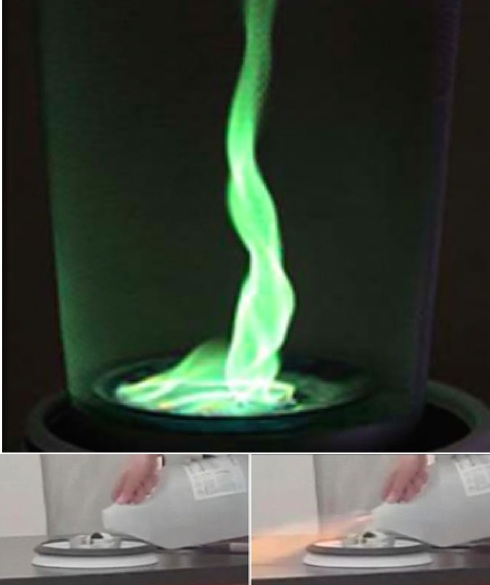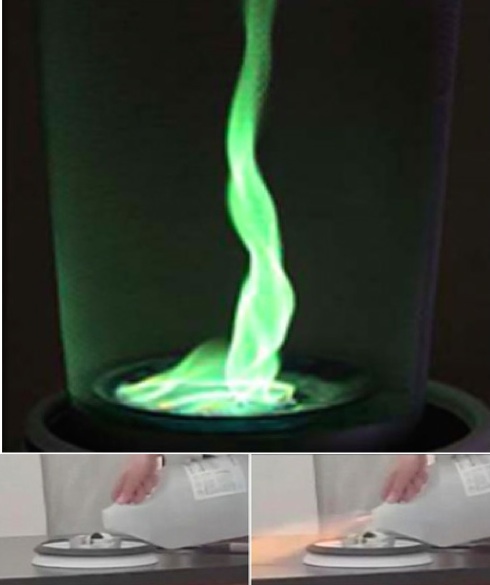Last week a team of CSB investigators deployed to the Terry Lee Wells Discovery Museum (The Discovery) in Reno, Nevada, where a flash fire on September 3 injured children and adults viewing a science demonstration. Nine people – eight of them children – were transported to the hospital for evaluation of burn injuries, and one child with more serious burns was admitted to the hospital for treatment.View of “fire tornado” demonstration
CSB investigators spent two days interviewing witnesses and museum personnel, examining the site, and reviewing relevant documents and safety procedures. The Discovery’s leadership and personnel cooperated fully with the investigation and expressed their desire for positive changes to prevent similar incidents in the future.
Our investigative team determined that the incident occurred during a “fire tornado” demonstration where salts of different elements were combusted in a dish in the presence of alcohol-soaked cotton balls, while spinning on a lazy Susan-type rotating tray. This produces a tornado-like colored flame that rises in the air. The incident happened during a version where boric acid was to be burned in the presence of a methanol-soaked cotton ball. When the cotton failed to ignite it was realized that it had not been adequately wetted with methanol. More methanol was added to the cotton from a four-liter (one gallon) plastic bottle. Unknown to personnel, the cotton ball was likely continuing to smolder, and it ignited the freshly added methanol and flashed back to the bottle. Burning methanol then sprayed from the bottle toward the nearby audience of adults and children visiting the museum.
This unfortunate incident is similar to a number of others that have occurred around the country during lab or classroom demonstrations where methanol has been used as a fuel for combustion. In 2006, high school student Calais Weber was severely burned, and others were injured, at an Ohio high school during a similar demonstration of a chemical “rainbow” that involved combusting salts with methanol. Calais’ burns were so serious she had to be placed in a medically induced coma and required multiple skin grafts. Calais’ ongoing ordeal was described in a poignant video we released in December 2013, called “After the Rainbow.”
In 2012, more students and a teacher were burned, and some were hospitalized, in a methanol-based experiment at a middle school in Liverpool, New York. Then in 2014, a high school student was severely burned by a methanol fire during another rainbow experiment gone awry. And there are many other examples.
Methanol igniting on the day of the incident Methanol is an essential chemical and an emerging energy resource with a multitude of important industrial and environmental uses. But in the cautionary words of Greg Dolan, CEO of the Methanol Institute, which represents the manufacturing community, “Like gasoline, methanol is a toxic and flammable chemical and should only be handled in appropriate settings, and that would certainly not include museums and classrooms.”
Methanol readily emits heavier-than-air flammable vapors and the liquid has a low flash point, meaning it can ignite at room temperature in the presence of an ignition source. This creates an unacceptable risk of flash fire whenever any appreciable quantities of methanol are handled in the open lab or classroom in the presence of pervasive ignition sources, such as open flames, heat sources, or sparks. There is also a significant risk of flashback to any nearby methanol bulk container, as was the case in this last incident in Reno, Nevada.
Similar concerns have been raised by the Committee on Chemical Safety of the American Chemical Society, which this year called on schools and teachers to immediately end all “rainbow” demonstrations involving methanol or other flammable solvents on open benches. In the words of ACS safety experts, “The ‘Rainbow’ demonstration performed on an open bench using a flammable solvent is a high risk operation.” There are well-known safer alternatives to the rainbow demonstration where no methanol is used, only wooden sticks soaked in chemical salts dissolved in water.
The recent incidents of methanol fires in schools are just one example of what can happen when lab demonstrations are adopted and used – with the best of educational intentions – but without a thorough review of the hazards and the development of robust safety procedures.
Today I am calling on all schools, museums, and science educators to discontinue any use of bulk methanol – or other similar flammables – in lab demonstrations that involve combustion, open flames, or ignition sources. There are safer alternative ways to demonstrate the same scientific phenomena, and many teachers are already using them. Any use of methanol or other flammables should be either avoided completely or restricted to minimal amounts, which have been safely dispensed at remote locations. Bulk containers of flammable liquids must never be positioned or handled near viewing audiences, especially when there are potential ignition sources present.
As scientists and engineers, we share in the enjoyment of both teachers and students in creating and watching chemical demonstrations. However, safety must be the absolute priority in all such endeavors. We have seen too many kids and adults suffer tragic injuries to do otherwise.




